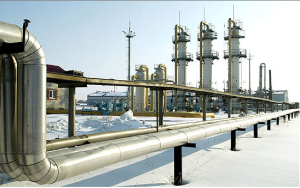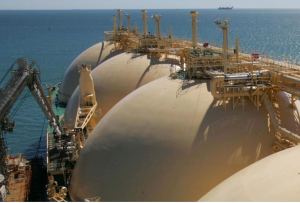Natural gas puts oil in crosshairs as transport fuel of choice
 From Reuters, London, Andrew Callus: Crude oil’s supremacy in motor fuels is pricing it out of power and industry, leaving it stuck in low-growth transport and vulnerable to a revolution that could favour natural gas.
From Reuters, London, Andrew Callus: Crude oil’s supremacy in motor fuels is pricing it out of power and industry, leaving it stuck in low-growth transport and vulnerable to a revolution that could favour natural gas.
International oil company BP PLC predicts worldwide oil demand growth of just 0.8 per cent a year up to 2030 – slower than for any other energy type and only half the projected total energy demand growth rate over the same period.
More Related to this Story
With cheaper fuels already pushing oil out of industrial and power generation use, any extra oil demand now has to come from vehicles, shipping and aircraft.
But transport is slow growing. Efficiency gains brought about by high prices and anti-pollution regulation are the main reason. BP’s Outlook 2030 study shows the fuel economy of new cars in the United States and China falling well below 5 litres per 100 kilometre by 2030, from between 7 and 8 litres now.
 In OECD countries, transport fuel demand is set to actually fall as weak economies, a shift to smaller cars, and a move to public transport in congested urban areas take a further toll, BP says. Worldwide, meanwhile, natural gas, biofuels and other alternatives are expected to steal almost a third of what growth there might be.
In OECD countries, transport fuel demand is set to actually fall as weak economies, a shift to smaller cars, and a move to public transport in congested urban areas take a further toll, BP says. Worldwide, meanwhile, natural gas, biofuels and other alternatives are expected to steal almost a third of what growth there might be.
There is no immediate worry for producers of oil. The world consumes over 30 billion barrels each year, and even with no growth, nearly a third of 2011’s proved global reserves of 1,653 billion barrels will be gone by 2030. Hence the urge to head for the Arctic and deeper into the oceans for new supplies.
Presenting BP’s report last week, the company’s chief economist Christof Ruhl called the energy industry “a slow-moving beast” and said the oil glut some now fear is no more likely than the now-discredited “peak oil” shortage predictions of a decade ago.
But he acknowledged surprise at the speed with which energy-use-per-unit-of-wealth-produced is falling around the world and said the pace of development in U.S. shale gas and shale oil had shocked the industry too.
Ian Taylor of the trading giant Vitol was asked in November about future oil industry shockers, or game changers. “I think it’s when the Chinese and Americans work out how to put [natural] gas in those trucks and only use gas for transportation,” he said, “and I’ve got a horrible feeling it may come a little bit quicker than we’re all anticipating.”
Natural gas is already converging on a similar overall market share to oil in the world’s energy mix, at 26 per cent to 28 per cent, and international oil companies reflect that trend by equalizing oil/gas exploration and production portfolios.
Their heavy spending on liquefied natural gas (LNG) facilities, which freeze and squeeze gas into ocean-going vessels, is internationalizing the gas market too. BP says LNG supplies will represent 15.5 per cent of gas consumption by 2015.
It is power generation, not transport demand, that is driving gas growth.
But by happy accident, the reduced bulk that makes LNG portable also makes it a viable transport fuel, and oil executives are starting to see a point at which familiarity and availability could tip the balance away from diesel and gasoline.
In a presentation last year, Total SA’s chief executive officer, Christophe de Margerie, said calorie for calorie, U.S. natural gas costs one-sixth the price of crude. Even with gasoline and diesel still so dominant, a U.S. truck driver converting to natural gas derivatives could recover the cost in months. “Something’s got to give if that differential stays around for long,” he said.
Royal Dutch Shell’s market-leading investments in LNG are well documented, as are its widely-promoted LNG-powered trucks in Canada. In October last year, it also commissioned two LNG-powered ships to service its Gulf of Mexico offshore rigs from Houston.
“You can rest assured they weren’t in any way the economic option,” a senior Shell executive said. “This was about sending a message, at the heart of the industry, at an important time.”
Last year, the National Petroleum Council (NPC), a group backed by Shell and other Big Oil players, lobbied in favour of the environmental and energy security benefits of a shift to cleaner-burning natural gas and other oil-efficient measures. Transportation in the United States should “evolve at an accelerated rate,” it said.

Even with the powerful oil industry behind a gas-for-transport revolution, the average “gas station” is unlikely to become exactly that overnight, probably leaving the biggest single slice of the transport industry, the private vehicle, to gasoline and diesel for some decades yet.
A more likely prize for LNG as a transport fuel is garbage trucks and other municipal service vehicles, along with mass transit systems like buses.
Trains, ships, and even aircraft are all potential targets, too. Buses powered by compressed natural gas (CNG) – LNG’s less potent older brother – already ply the streets of Dallas and other cities. Rotterdam and Singapore have both outlined plans to become a hub for LNG-powered shipping.
There’s plenty to aim at here. International shipping and aviation fuel plus road freight will account for about 15 million barrels a day of oil demand by 2035, according to the International Energy Agency (IEA). That is a quarter of the projected 60-million-barrel daily oil-for-transport pot.
LNG-powered ships are already a reality, even though the fleet is modest for now. A report by ship classifiers Det Norske Veritas last year predicted that 30 per cent of new vessels will be LNG-powered by 2020. Tankers that carry LNG are an obvious early target. Another classifier, Lloyd’s Register, said the use of LNG as a fuel will pick up from 2019 and could be as much as 8 per cent of global bunker fuel demand before 2025.
Airlines have yet to crack the LNG nut, but the first commercial gas-powered civil aircraft flight left Doha for London on Jan. 9 this year, fuelled by another potential gas-to-transport game-changer – jet fuel made from gas.

Gas-to-liquids (GTL) technology is, for the time being, only economic on the very biggest scale. Shell’s Pearl GTL plant in Qatar taps the world’s biggest standalone gas field and supplied the fuel for that Qatar Airways Airbus A340-600 flight. Cheap U.S. gas is changing that, and Shell is looking to copy its Pearl success in the United States.
BP’s figures puts gas at 5 per cent of the transport fuel market by 2030, overtaking biofuels, which are already near that level. Oil’s share will have fallen by then to 89 per cent from 94 per cent presently.
Nowhere is the pressure on oil-based transport fuels stronger than in the United States, where oil’s biggest competitor, natural gas, has become very cheap – also as a result of innovations at the production end of the industry.
It is hard to measure how much fuel substitution is happening already, but analysts point to U.S. Energy Information Agency (EIA) data showing diesel mysteriously stuck below its 4 million barrels a day pre-financial crisis levels, even though the economy has been expanding since 2009.
U.S. price gaps aside, BP’s predictions, like those of other forecasters, put China centre stage as the driver of global energy demand growth.
It says China will account for approaching half of the 0.8-per-cent a year growth in oil demand it expects by 2030 – some 7 million barrels a day out of a total extra 16 million barrels.
Here again, LNG could make inroads.
In October last year, China unveiled a policy specifically designed to spur the transport sector’s use of LNG as part of its push to clean up the heavily polluted air of its cities.
The Natural Development and Reform Commission policy targets buses, taxis and shipping and sets a target for gas to fill 10 per cent of energy demand by the end of the decade.
Five LNG import terminals have already sprung up along China’s east coast, and another dozen are planned. That is gas for the decades to come.
Beyond that, a recent EIA report made China the site of the biggest technologically recoverable reserves in the world of the shale gas that is changing the U.S. energy landscape.
“If the Chinese could do this, it would have enormous implications for them, for the oil industry, and possibly for global LNG trade too,” EIA chief Adam Sieminski said in an interview in November, 2012.
Additional reporting by Peg Mackey in London and Chen Aizhu in Beijing.
Category: Fuel & Oil, General Update










